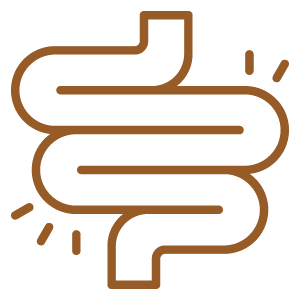Often referred to in herbal medicine as the “mother of the gut”, chamomile (Matricaria chamomilla) is known for its gentle yet profound medicinal qualities. This versatile herb, with its sweet, apple-like fragrance, has been employed for centuries to treat a variety of ailments, including a digestive issues and anxiety. Chamomile’s soothing properties make it a popular remedy for gastrointestinal discomfort, inflammation, and sleep disturbances. The delicate flowers are rich in flavonoids and essential oils, which contribute to their wide range of therapeutic benefits. Notably, chamomile’s anti-inflammatory and antispasmodic effects are well-documented.
Key Benefits:
- Digestive Support: Chamomile is highly valued for its ability to alleviate digestive disturbances, such as bloating, gas, spasm, heartburn and indigestion – particularly when they are related to stress (McIntyre, 2019). Its antispasmodic properties help to relax the smooth muscles of the digestive tract, which is particularly beneficial for those suffering from irritable bowel syndrome (IBS) (Madisch et al., 2004). The herb is also known to enhance digestion and soothe the gastrointestinal tract, making it an excellent choice for addressing persistent indigestion (Madisch et al., 2001). Chamomile is rich in bisabolol, which protects the stomach against lesions and ulcers, and speeds the healing of any existing ulcers (Bezerra et al., 2010), so it is well indicated for gastritis and peptic ulcers (McIntyre, 2019). It also contains naturally antimicrobial essential oils, which help resolve digestive infections; and its bitter compounds stimulate the flow of bile and the secretion of digestive juices (McIntyre, 2019).
- Anti-inflammatory and Wound Healing Properties: Chamomile’s potent anti-inflammatory effects make it an excellent remedy for treating skin conditions such as eczema, wounds, and other irritations. Its components chamazulene, alpha-bisabolol and apigenin have been thoroughly studied for their anti-inflammatory activity (McKay & Blumberg, 2006; Srivastava et al., 2009). Its effectiveness in reducing inflammation and promoting wound healing has been supported by clinical studies (Glowania et al., 1987). Chamomile’s application in eczema treatment highlights its role as a gentle yet powerful anti-inflammatory agent (Ross, 2003).
- Stress, Anxiety and Sleep Aid: Chamomile is widely recognized for its calming effects, particularly in reducing anxiety and promoting restful sleep. Clinical trials have demonstrated its efficacy in alleviating symptoms of generalised anxiety disorder, with significant reductions in anxiety levels reported among participants (Amsterdam et al., 2009). Furthermore, chamomile has shown potential antidepressant activity, which may be especially beneficial for those experiencing both anxiety and depression (Amsterdam et al., 2012). Its soothing properties make chamomile an ideal herb for those struggling with stress-related conditions. It is an excellent relaxant for babies and children who are restless, prone to colic, and have sleeping problems (McIntyre, 2019).
- Headaches and Pain Relief: Chamomile helps relieve pain in headaches and migraines (McIntyre, 2019). In 2018, a crossover study demonstrated a beneficial effect of topical German chamomile oleogel as pain relief in migraine without aura (Zargaran et al., 2018). Flavones apigenin, luteolin and apigenin 7-O-beta-glucoside, contained in the essential oils of chamomile, are not only absorbed at the skin surface, but they also penetrate into deeper skin layers (Merfort et al, 1994). A 2024 randomised, double-blind, placebo-controlled clinical trial has found chamomile to significantly contribute to preventing post-dural puncture headaches in women undergoing electric caesarean sections (Hosseinipour et al., 2024). Research suggests that the analgesic properties of chamomile extend beyond headaches and migraines, to various kinds of pain, whether acute or chronic (Shakeri et al., 2012).
- Menstrual Health: Chamomile is traditionally used to ease menstrual cramps, breast pain, premenstrual headaches and other symptoms associated with premenstrual syndrome (PMS) (McIntyre, 2019). The herb’s antispasmodic action helps to relieve uterine contractions, providing comfort during menstruation. Studies have shown that chamomile can significantly reduce both the physical and emotional symptoms of PMS, making it a valuable ally for women’s health (Khalesi et al., 2019). Additionally, chamomile has been found to reduce menstrual bleeding, further supporting its role in menstrual health (Mollabashi et al., 2020). A randomised controlled trial in 2018 has shown that chamomile is a well-tolerated and effective treatment for mild to moderate cyclic mastalgia, or breast pain in the days leading up to a period (Saghafi et al., 2018). It can also help address menopausal symptoms (Kupfersztain et al., 2003).
- Immune Support: Chamomile’s immunomodulatory effects make it a valuable herb for enhancing the body’s natural defences. Regular consumption of chamomile tea has been linked to increased antibacterial activity, which helps protect the body from infections (Srivastava et al., 2010). This makes chamomile particularly useful during cold and flu season, providing a natural boost to the immune system. Its volatile oils have powerful antiseptic properties, active against bacteria, including Staph. aureus, and fungal infections, including Candida (McIntyre, 2019). It can also be used as a natural antihistamine for allergies (Kobayashi et al., 2025).
Safety
While chamomile is widely regarded for its gentle and soothing properties, and generally considered safe (EMA, 2015), certain cautions should be observed. Individuals with allergies to plants in the Asteraceae family, such as ragweed, marigolds, and daisies, may experience allergic reactions, including severe cases like anaphylaxis (Jensen-Jarolim et al., 1998; Hoffmann, 2003). Chamomile may also interfere with the absorption of iron, making it advisable for individuals with anaemia to avoid taking it simultaneously with meals or iron supplements (Mills & Bone, 2005). Moreover, the European Medicines Agency advises against the use of chamomile in baths for individuals with large skin injuries, acute skin conditions, or cardiovascular issues due to potential adverse effects (EMA, 2015). As with any herbal remedy, it is best to consult with a qualified medical herbalist before using large amounts of chamomile, especially if you have a pre-existing medical condition or are taking prescription medications.












Leave a comment